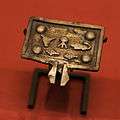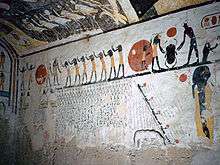The
ancient Egyptian Sun-shining-with-rays hieroglyph,
Gardiner sign listed no. N8, is a portrayal of the 'sun, with rays shining down from it'; it commonly is portrayed with 3-rays; older versions may have 4-rays, and an equivalent version is closer in form to the hieroglyph for the faience necklace (hieroglyph), Gardiner no. S16, with
elongated 3-rays,
In the Egyptian language, the sun-with-rays hieroglyph is used as an ideogram, determinative, and phoneme.[1]
Rosetta Stone usage
One example usage from the 198 BC
Rosetta Stone is from line R10 of the engraved stone and is shown in the photo text. A double crown-(pschent crown) is to be made for the statue of the pharaoh, and a description of how it is to be mounted is given. The end of the specifications are:
- "...an uraeus likewise on a basket [and] a papyrus cluster under her on her angle(=corner) left, the meaning whereof is, The Lord of the Two Crowns illumineth the Two Lands-(Egypt)..Inasmuch as..."[2]
The reference is to Egyptian language, 'hedj' for silver, s-h(dj)-(s-ḥḏ) for "illumineth", using the sun-with-rays as a determinative in a composition block.
(The photo text shows the hieroglyph appears more like the 'faience necklace hieroglyph').
3rd millennium BC, ivory wands
Magical Egyptian ivory wands from the 3rd millennium BC, and specifically by 2100 BC show magical protective animals, gods, and Egyptian hieroglyphs. One common god is Bes. A complex iconographic designed ivory wand has lions, walking and reclining, a crocodile head, a large scarab, a ram-head, wearing a crown, Apep, and Heket upon her basket. Also shown a uraeus, gazelle-headed staffs with knife, a serpopard, and a total of 10 knives, one held by the standing Hippopotamus God, one hand on the Sa-protection hieroglyph. The entire iconography is complex.
The
sun-shining-with-rays hieroglyph is shown once, in front of the crown, upon the Ram-head. It is faience-like, is like the
sun hieroglyph, no. N5, with its central dot,
, and has 4 vertical, and undulating
rays of light.
[3]
Hieroglyphs from coffin lid of
AnkhnesneferibreAmulet-(2.70cm wide):
Hotep offering table, with Ox-head, Trussed Goose, Grape Bunch, and Sun-shining-with-rays
Relief
Edfu Temple
Dendera Temple
See also
References
- ↑ Betrò, 1995. Hieroglyphics: The Writings of Ancient Egypt, Sun with Rays, p. 152.
- ↑ Budge, 1989, (1929). The Rosetta Stone, p. 161-162.
- ↑ Fleming; Lothian; (and Fletcher), 1997. The Way to Eternity: Egyptian Myth, p. 124-126.
- Betrò, 1995. Hieroglyphics: The Writings of Ancient Egypt, Betrò, Maria Carmela, c. 1995, 1996-(English), Abbeville Press Publishers, New York, London, Paris (hardcover, ISBN 0-7892-0232-8)
- Budge. The Rosetta Stone, E.A.Wallace Budge, (Dover Publications), c 1929, Dover edition(unabridged), 1989. (softcover, ISBN 0-486-26163-8)
- Fleming; Lothian; (and Fletcher), 1997. The Way to Eternity: Egyptian Myth, Fergus Fleming, Alan Lothian, and consultant Dr. Joann Fletcher. c 1997, Duncan Baird Publishers. (hardcover, ISBN 0-7054-3503-2)
_(Vall%C3%A9e_des_Rois%2C_Th%C3%A8bes_ouest)_-8.jpg)

 Hieroglyphs from coffin lid of Ankhnesneferibre
Hieroglyphs from coffin lid of Ankhnesneferibre Amulet-(2.70cm wide): Hotep offering table, with Ox-head, Trussed Goose, Grape Bunch, and Sun-shining-with-rays
Amulet-(2.70cm wide): Hotep offering table, with Ox-head, Trussed Goose, Grape Bunch, and Sun-shining-with-rays Relief
Relief Relief in Dendera Temple
Relief in Dendera Temple Edfu Temple
Edfu Temple Dendera Temple
Dendera Temple